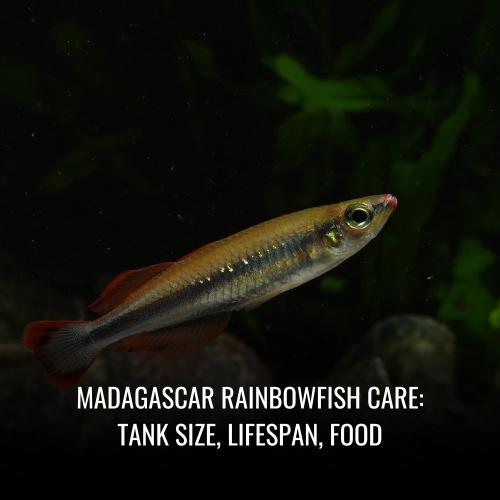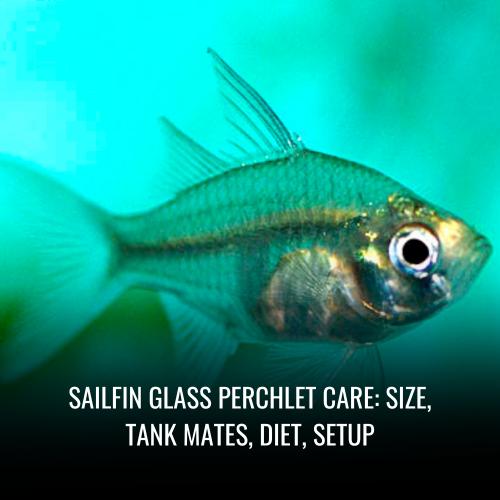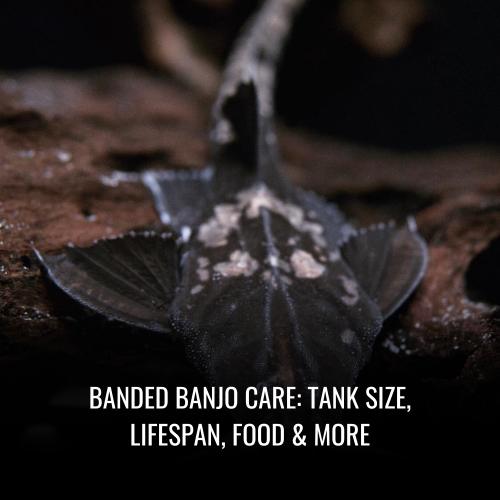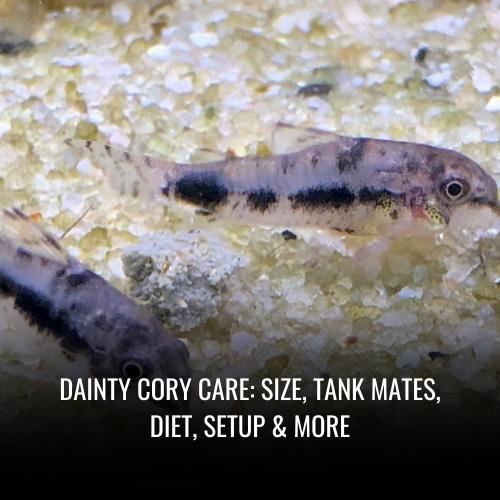African Moon Tetra Care: Tank Size, Lifespan, Food & More
This post contains affiliate links. As an Amazon Associate, we earn from qualifying purchases.
The African moon tetra is a beautiful and intriguing freshwater fish that has captured the interest of aquarists around the world. Known scientifically as Bathyaethiops caudomaculatus, this peaceful species is part of the family Alestidae and boasts an attractive color palette that makes it a standout in planted aquariums.
| Characteristic | Details |
|---|---|
| Scientific Name | Bathyaethiops caudomaculatus |
| Common Name | African Moon Tetra |
| Family | Alestidae |
| Usual Size in Fish Tanks | 2 inches (5 cm) |
| Recommended pH Range | 5.5 – 7.5 |
| Recommended Water Hardness (dGH) | 5-19 (soft to moderately hard) |
| Recommended Temperature | 22 – 26 °C (71.6 – 78.8°F) |
| Reproduction Method | Egg layer |
| Origin | Democratic Republic of Congo, West Africa |
| Temperament to its own Species | Peaceful, shoaling fish |
| Temperament Toward Other Fish Species | Generally peaceful |
| Usual Place in the Tank | Middle to top dweller |
| Lifespan | 3-5 years |
| Tank Size Requirement | At least 20 gallons for a small shoal |
| Filtration System | Moderate, with gentle water flow |
| Sexual Dimorphism | Females slightly larger and rounder |
| Substrate Cleaning | Not necessary; focus on water quality |
Scientific Name
Bathyaethiops caudomaculatus Although it has been known by other scientific names such as Micralestes breuseghemi and B. breuseghemi, the African moon tetra’s current accepted nomenclature is Bathyaethiops caudomaculatus. The name draws attention to its distinctive black spot at the base of the caudal fin, with ‘caudo’ meaning tail and ‘maculatus’ indicating a spot.
Average Size
Typically, an African moon tetra grows to an average size of about 2 inches (5 cm) in the home aquarium. They possess a slender, streamlined body, which makes them adept swimmers, perfect for navigating the gentle water flow of their native environments. Females tend to be slightly larger and rounder, especially when gravid.
Lifespan
With proper care, water quality, and nutrition, African moon tetras can live for 3 to 5 years in captivity. Ensuring a stress-free environment that closely mimics their natural habitat is key to a long and healthy life for these delicate shoaling fish.
Natural Habitat
The African moon Tetra is indigenous to the Democratic Republic of Congo. They call the slow and gentle waters of the Congo River basin home, paddling through areas rich in plant life and residing in slightly acidic water conditions. They prefer water with a pH range of 5.5 to 7.5, which replicates the water chemistry of their African rivers.
Appearance
The African moon tetra is a striking freshwater fish known for its deep-bodied structure and shimmering gold coloration. A key feature of this species is the prominent black spot located at the base of the caudal fin, making it easily identifiable. Additionally, adult moon tetras typically attain a length of approximately 8 cm (3 inches).
Beneath their dorsal fin, observers can note a smaller red spot, creating a contrast that adds to their visual appeal. Sexual dimorphism in this species is subtle, with females generally showcasing a more rounded, deeper body shape than their male counterparts. The African moon tetra’s notably large eyes and transparent fins contribute to their captivating presence in any aquatic setting.
| Characteristic | Appearance |
|---|---|
| Body Shape | Deep-bodied |
| Size | Approximately 8 cm (3 inches) in length |
| Primary Coloring | Gold |
| Distinguishing Spots | Black spot at caudal fin base, smaller red spot under dorsal fin |
| Fins | Clear, transparent fins |
| Eyes | Relatively large |
| Sexual Dimorphism | Females have rounder, deeper bodies |
Sexing: Male vs Female African Moon Tetras
Identifying the sex of African Moon Tetras can be relatively straightforward, especially when observing certain physical characteristics and behaviors. Males are typically more colorful and exhibit a definite vibrancy in their hues that becomes even more pronounced during periods of courtship. Their fins differ as well, with the anal fin being more pointed and extended.
In contrast, females present a more rounded bodily shape, which becomes apparent as they age. This distinction is especially noticeable when females carry eggs, as their abdomens appear fuller. While males often demonstrate heightened activity and may behave aggressively towards one another in pursuit of female attention, females are generally less boisterous.
Here’s a brief list to summarize the differences:
Males:
- More vibrant colors.
- Pointed and elongated anal fin.
- Active and occasionally aggressive courtship behavior.
Females:
- Rounded appearance with fuller abdomen when carrying eggs.
- Shorter and rounder anal fin.
- Less active in displaying.
Behavior & Temperament
The African moon tetra exhibits a serene and peaceful demeanor, making them an excellent candidate for community tanks. Often noted for their active and spirited swimming, they display an endearing shoaling behavior, which emphasizes the importance of keeping them in groups.
Their reclusive nature prefers the solace of well-decorated tanks replete with hiding spots like dense vegetation or driftwood. This setup not only garners a sense of security for these tetras but also provides onlookers with a more natural, engaging view of their behavior.
Despite their playful chasing at times, African moon tetras are not known for aggression and do not tend to engage in fin nipping with other fish. To replicate their natural habitat and contribute to their well-being, a gentle water flow in the aquarium is essential.
Observing their interspecies interactions and social antics makes for a lively display, particularly when they are kept in larger schools within the tank.
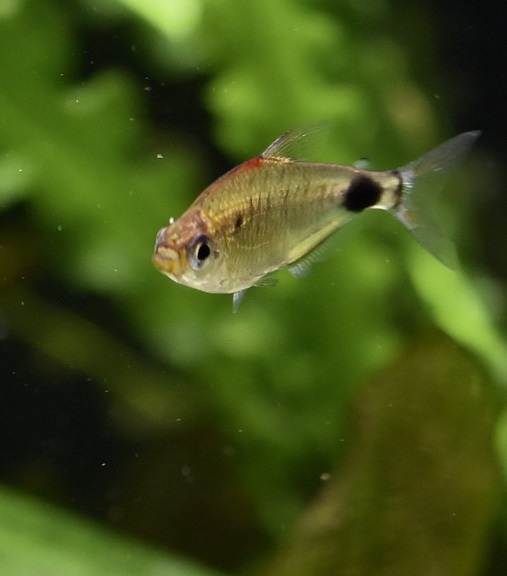
Are African Moon Tetras Fin Nippers?
African moon tetras are generally not fin nippers. They interact with their tank mates in a peaceful, non-invasive manner, which makes them compatible with other gentle fish. The absence of aggressive fin nipping tendencies contributes to their reputation as beautiful and harmonious members of a mixed-species aquarium. To maintain this congenial environment, it is crucial to provide a habitat with ample hiding places and a well-structured aquascape to minimize stress.
Are African Moon Tetras Aggressive To Each Other & Other Fish?
Between themselves and other tank mates, African moon tetras display a non-aggressive nature. They thrive in a school of at least 8-10 members, which enhances their collective well-being. They are best paired with other species that share their peaceful disposition to ensure a tranquil tank community.
Are African Moon Tetras Friendly To Each Other & Other Fish?
African moon tetras are amiable fish that exhibit their best attributes when kept in groups. They partake in friendly interactions with both their species and others within the aquarium. Housing them with similarly sized, non-aggressive fish allows their pleasant nature to shine, enriching the peaceful ambience of their environment.
Are African Moon Tetras Schooling Fish?
Indeed, African moon tetras are classified as schooling fish. For optimal health and display of natural behaviors, it is advised to keep them in a group of at least six. Their schooling nature plays a pivotal role in their overall welfare by mitigating stress and promoting vibrant colors.
Can You Have Just One African Moon Tetra In The Tank?
It is not recommended to keep a solitary African moon tetra. Isolation can cause undue stress and lead to a decline in health and well-being. As social beings, they gravitate towards the company of their kind, which duly replicates their natural living conditions. Providing them with the companionship of a school is necessary to foster a secure and healthy lifestyle for these shy fish.
Do African Moon Tetras Need To Be In Groups?
To ensure the natural and healthy behavior of African moon tetras, a group setting is vital. Group living minimizes stress and magnifies their confidence, which in turn manifests as more vibrant coloration and increased activity levels. A grouping of 8-10 tetras is ideal, offering not only a more scenic aquarium but also a habitat that echoes the dynamics of their natural environment and strengthens their social network.
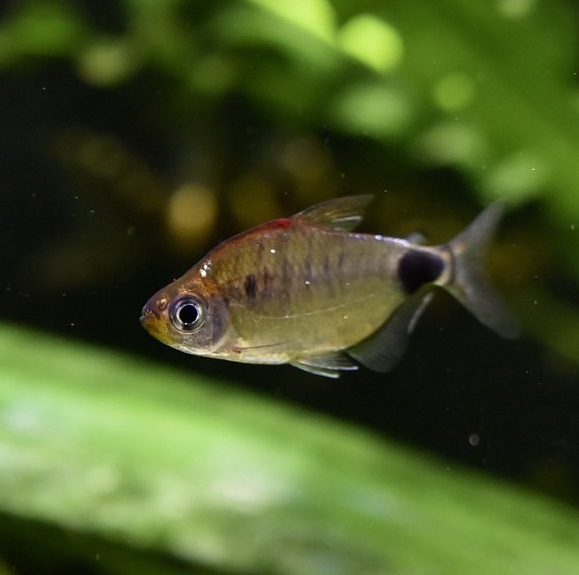
Food & Diet
African Moon Tetras display an omnivorous diet that reflects their opportunistic feeding habits in the wild. Though not solely dependent on algae, they do engage in incidental consumption of various algae types present in their habitat. This might include green, brown, or even brush algae.
In the confines of an aquarium, these tetras will explore and nibble on algae growing on surfaces, offering a natural form of environmental upkeep. Nonetheless, to ensure their nutritional requirements are fully met, it is essential to provide a diverse diet.
A mix of high-quality flake or pellet foods complemented by occasional servings of live or frozen fare enriches their diet, creating a well-rounded nutritional profile necessary for their health and vitality.
Do African Moon Tetras Eat Shrimp?
African Moon Tetras show a particular affinity for live and frozen prey, with shrimps forming a part of their eclectic food choices. Small shrimps such as ghost shrimp and cherry shrimp are suitable for them, contributing to a substantial and nourishing intake.
Do African Moon Tetras Eat Bloodworms?
Bloodworms, a popular dietary choice among freshwater fish, are relished by African Moon Tetras. In their natural environment, these worms constitute a staple in their diet, contributing significantly to the tetras’ protein intake.
In captivity, bloodworms can be dispensed as live, frozen, or freeze-dried, and serve as an incentive for African Moon Tetras to indulge in their instinctual feeding behaviors. Regularly including bloodworms in their diet supports robustness, vivacity, and their striking colors, ultimately playing a crucial role in their well-being within an aquarium setting.
Do African Moon Tetras Eat Mosquito Larvae?
Mosquito larvae, a protein-rich and nutritious type of food found in their native waters, are an attractive meal for African Moon Tetras. Whether live or frozen, these larvae serve as an excellent occasional treat for the tetras, significantly diversifying their dietary spectrum. It is the similarities to their natural diet that make these larvae such an important food item for shaping the health and natural character of African Moon Tetras in captivity.
Do African Moon Tetras Eat Planaria?
While African Moon Tetras are versatile in their eating habits, planaria do not regularly feature in their diet. Their inclination leans towards a carnivorous diet dominated by small insects, worms, and crustaceans. As planaria are not among their favored or natural dietary items, it is uncommon for African Moon Tetras to hunt for or consume these flatworms in a home aquarium.
Do African Moon Tetras Eat Plants?
African Moon Tetras are not voracious plant eaters. Though small quantities of plants may be ingested sporadically, particularly soft and new plant growths, their diet is predominantly composed of protein sources.
African Moon Tetra Tank Mates
African Moon Tetras, originating from the Congo River in West Africa, are not only beautiful but also peaceful freshwater fish. They are the epitome of a community tank member, cohabiting harmoniously with other calm species. To truly appreciate their beauty, it’s recommended to house them in schools of at least 8-10. This not only promotes their well-being but transforms your aquarium into a vibrant, lively habitat.
When choosing tank mates for African Moon Tetras, opt for species that mirror their peaceful demeanor. Ideal companions include smaller, non-aggressive fish that won’t bully or outcompete them for food. Consider other tetra species, or similarly gentle fish, to keep the environment serene.
However, it’s crucial to avoid pairing them with larger, more energetic fish that could intimidate these timid swimmers. A tranquil tank landscape, replete with sand or fine gravel substrate coupled with dense vegetation and rock formations, provides a sanctuary for these shoaling fish.
| Ideal Tank Mates | Avoid |
|---|---|
| Small Tetra Species | Large, Boisterous Fish |
| Non-aggressive Fish | Predatory Species |
| Gentle Water Flow | Erratic Water Conditions |
With this guidance, you can create a thriving aquarium where your African Moon Tetras can live in harmony with their tank mates.
Aquarium Setup
Creating the perfect environment for African Moon Tetras is key to their health and happiness. They flourish in well-planted aquariums with vegetation like Java Moss, which offers ample hiding and exploration opportunities. These beautiful fish are relatively sensitive to water conditions, so maintaining a stable atmosphere is paramount.
Ideal Tank Size
For anyone looking to add African Moon Tetras to their collection, a tank of at least 20 gallons is advisable. This size caters to their shoaling nature and ensures there’s enough space for them to exhibit active swimming behaviors. A larger group of African Moon Tetras, however, will require more space, and thus a 30-gallon tank is preferable.
- Minimum Tank Size: 20 gallons for small group
- Recommended Tank Size: 30+ gallons for a larger shoal
- Aquarium Shape: Longer tanks preferred over taller ones
Ideal Water Parameters
Replicating the natural water conditions of the African Moon Tetra’s West African habitat will make them feel right at home. Aim for a gentle water flow and
- pH Range: 6.0 to 7.5
- Temperature: 73°F to 77°F (with a maximum of 82°F)
- General Hardness (GH): 5 to 12
- Regular water checks and adjustments: To maintain stable water parameters
Filtration
Given their sensitivity to water conditions, African Moon Tetras benefit greatly from efficient filtration. Select a filter that provides gentle water flow and combines mechanical, biological, and chemical filtration.
This ensures waste removal, the growth of beneficial bacteria, and the elimination of toxins. Nevertheless, it’s important to avoid over-filtration to prevent stress from strong currents. Regular maintenance of the filter and water changes are non-negotiable for the well-being of your African Moon Tetras.
- Filtration Type: Mechanical, biological, and chemical
- Water Flow: Gentle, avoiding over-filtration
- Maintenance: Regular water changes and filter maintenance
Lighting
Lighting should mimic the African Moon Tetra’s natural day and night cycles, with 8-12 hours of light per day being the norm. Avoid bright, direct lighting which can stress the fish. Instead, opt for dimmer, subdued lighting conditions with floating plants or dense vegetation to simulate dappled light. Automated timers can be utilized to create natural transitions, adding to the comfort of these fish.
- Light Cycle: 8-12 hours per day
- Lighting Intensity: Subdued, avoiding high intensity
- Vegetation: Floating plants or dense coverage for dappled lighting
- Timers: For natural transitions between day and night
With these guidelines, you will provide a stable and nurturing environment for your African Moon Tetras to thrive, reflecting both their natural tendencies and their need for a clean and serene home.
Common Possible Diseases & Prevention
African Moon Tetras, like many freshwater fish, are at risk of contracting illnesses such as ich, which manifests as white spots, along with fin rot and fungal infections. To shield these graceful swimmers from disease, a proactive approach is essential. Good water quality is the cornerstone of disease prevention—this includes regular water changes to maintain a pristine environment.
A crucial step in disease prevention is quarantining new arrivals. By isolating new fish, you minimize the risk of introducing pathogens to your established African Moon Tetra community. Remember, the well-being of your fish also depends on the social dynamics of the tank. Ensuring that tank mates are compatible and that the environment isn’t overpopulated will help prevent stress-induced vulnerability to sickness.
Feeding your tetras a balanced diet is vital for their immune strength. Pair this with consistent, suitable water parameters and a tranquil habitat, and you pave the way for a healthy life for these delicate fishes. Addressing these preventative measures affords your African Moon Tetras the best chance of living a disease-free life.
| Prevention Measure | Method |
|---|---|
| Water Quality Management | Frequent water changes, avoid overstocking |
| Quarantine New Arrivals | Isolate newcomers to prevent disease spread |
| Stress Reduction | Select peaceful tank mates, control population |
| Diet and Nutrition | Provide a balanced, varied diet |
| Monitor Water Conditions | Regular checks and adjustments to parameters |
Breeding African Moon Tetra In Aquarium
African Moon Tetras require delicate care when breeding in captivity. A separate breeding tank is essential, equipped with fine-leaved plants that foster egg adherence. This environment protects the precious eggs, as adult tetras tend to consume them if left in the main tank.
Creating the right ambiance is vital. The breeding tank should offer a softer glow, with temperatures slightly higher than the main tank, typically between 78-80°F. These conditions encourage African Moon Tetras to exhibit their natural spawning behaviors.
Moreover, replicating their natural acidic water habitat boosts breeding success. Aim for a pH range of 6.0-6.5 with subdued lighting. After spawning, it’s imperative to remove parents to safeguard the eggs.
Feeding the offspring warrants special care, starting with infusoria or commercial liquid fry food. As they grow, integrate baby brine shrimp and finely crushed flakes into their diet. Constant surveillance of water quality and stability is paramount for the young tetras’ health.
| Breeding Requirement | Description |
|---|---|
| Separate Breeding Tank | Furnished with fine-leaved plants |
| Water Temperature | Slightly warmer: 78-80°F |
| Water pH Level | Acidic: 6.0-6.5 |
| Lighting | Dim, subdued lighting |
| Post-spawning Care | Remove parents to protect eggs |
| Initial Fry Diet | Infusoria, commercial liquid fry food |
| Advanced Fry Diet | Baby brine shrimp, crushed flakes |
| Water Quality Management | Vigilant monitoring and maintenance |
Adhering to these specific breeding procedures promises the chance to observe the captivating life cycle of African Moon Tetras, from spawning to the emergence of a new shoaling fish generation.
Are African Moon Tetra Easy To Keep?
Yes, African moon tetra’s peaceful nature makes them an excellent match for both novice and seasoned aquarists looking to add a touch of vibrance and serenity to their tanks. These beautiful fish are undemanding in regard to diet and water conditions, which facilitates their maintenance in a consistent and well-managed aquarium environment.
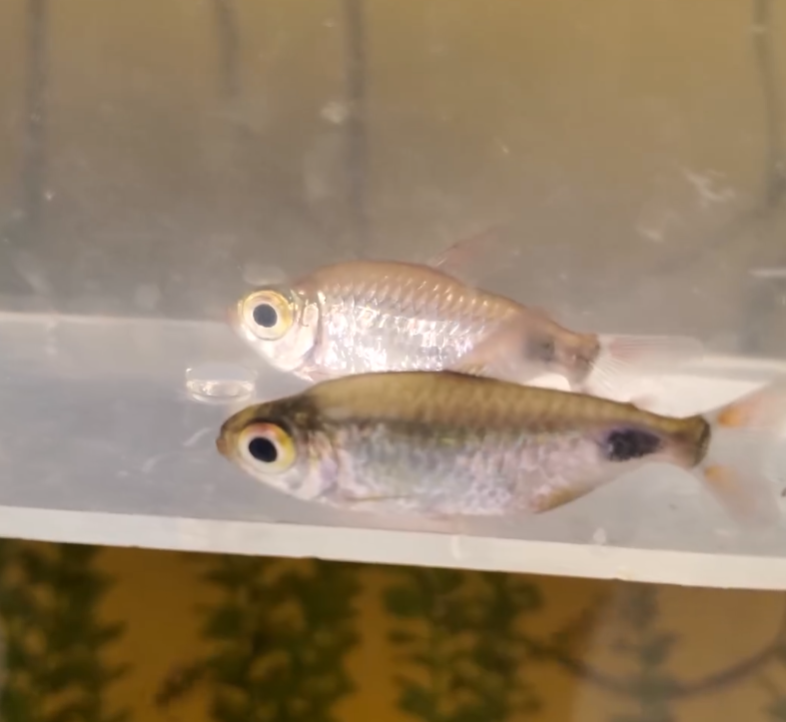
Are African Moon Tetra Sensitive To Water Changes?
African moon tetra demand a stable environment, with particular sensitivity to rapid changes in water parameters, notably pH and temperature shifts. Unexpected alterations can trigger stress in these freshwater fish, rendering them more prone to illnesses and other health complications. It’s crucial that any changes to their aquatic habitat, such as during routine tank maintenance, be conducted with a gentle hand to preserve the delicate balance.
For keepers of African moon tetra, it’s imperative to implement gradual acclimatization processes when introducing these fish to new conditions. This discipline helps to mitigate stress and supports their adjustment to a changing environment. Regular monitoring of the aquarium’s chemistry and cautious execution of water modifications stand as essential practices to sustain the African moon tetra’s health and the stability of their habitat.
Are African Moon Tetra Sensitive To Ammonia?
African moon tetras are particularly sensitive to ammonia. Elevated ammonia levels pose a serious threat, potentially culminating in severe stress, sickness, or in adverse cases, fatality. In the tropical aquaria they inhabit, any notable rise in ammonia is a red flag and warrants immediate attention.
Are African Moon tetra Sensitive To Copper?
Copper sensitivity is a significant concern for African moon tetra, as exposure to even low levels of this metal can lead to grave consequences. Consequently, when an ailment arises in the tank, using copper-based therapies must be reconsidered, as it poses a risk to these delicate fish. Symptoms associated with copper toxicity in African moon tetras can range from listlessness to more severe health issues.

